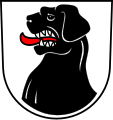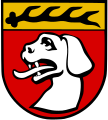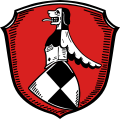Bracke (heraldic animal)
The pad (after the group of dogs Bracken ) symbolizes since the Middle Ages as emblem of the hunting justice . The depiction is in the form of a strong dog with often clearly emphasized occiput and broad, drooping ears, which are also emblazoned as hangers . Another name in heraldry is the Molossian . The hound belongs to the group of common figures , is usually shown in black or silver and with its tongue knocked out. All forms of representation and movement for dogs (standing, striding, jumping, sitting, lying, feeling, mutilated) with raised or lowered head are used. As a dog, the hound often wears a wide neck (as a collar (set with precious stones or otherwise highlighted), spiked collar with a ring loop, guide ring, guide rope or chain). As with many common figures, the bracken elevation is often dependent on the era and style. Often only the bracken head (head with attached neck) or the growing bracken trunk (head, neck and torso) is shown. In this form it is used as a helmet ornament , that is, as part of the upper coat of arms .
The Hohenzollern family have had the brackish head in their coat of arms since around 1317. The leadership as a helmet cover in the coat of arms is said to have been bought by Leubold von Rehberge (Rechensberg) on April 10, 1317.
The princes of Reuss (on the coat of arms) and the city of Bad Lobenstein , but also Brackenheim ( Württemberg ) have it in their coat of arms . In the last mentioned coat of arms it is a talking coat of arms .
Brackenhaupt in Bad Lobenstein
Bracke in the Brackenheim coat of arms
Brackenhaupt in the coat of arms of Mögglingen
Brackenhaupt in the coat of arms of Urbach
Bracke in the coat of arms of Hohnstein (Saxon Switzerland)
golden bracken head in the upper coat of arms of Heiligenberg
Brackenkopf in the coat of arms of the Hohenzollern family
Bracken hull in the family coat of arms of the Counts of Oettingen
Brackenhaupt in the coat of arms of the Lords of Urbach
Brackenhaupt in the coat of arms of Neustadt an der Aisch
Cadolzburg : Between the stags of a stag
Brackenhaupt in the coat of arms of Langenzenn
Web links
Individual evidence
- ^ Max Döllner : History of the development of the city of Neustadt an der Aisch up to 1933. Ph. CW Schmidt, Neustadt ad Aisch 1950. (New edition 1978 on the occasion of the 150th anniversary of the Ph. CW Schmidt Neustadt an der Aisch 1828–1978. ) P. 729.












